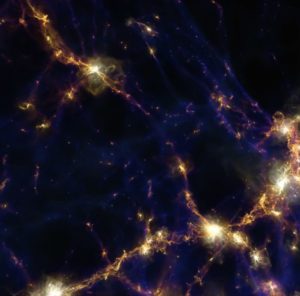 In this video, the “Illustris” scientific simulation begins just 12 million years after the Big Bang and illustrates the formation of stars, heavy elements, galaxies, exploding super novae and dark matter over 14 billion years. The music is by Neil Young, a bit of synchronicity that I stumbled upon.
In this video, the “Illustris” scientific simulation begins just 12 million years after the Big Bang and illustrates the formation of stars, heavy elements, galaxies, exploding super novae and dark matter over 14 billion years. The music is by Neil Young, a bit of synchronicity that I stumbled upon.
We hope that the Illustris simulation will be of interest to scientists of all disciplines as well as to the broader non-scientific community. Below we describe the ‘what’, ‘why’, and ‘how’ of the project at a level accessible to those without any expertise in physics, astronomy, or computer science.
Motivation & Big Ideas
The standard model of cosmology posits that the mass-energy density of the Universe is dominated by unknown forms of dark matter and dark energy. Testing this extraordinary scenario requires precise predictions for the formation of structure in the visible matter, which is directly observable as stars, diffuse gas, and accreting black holes. These components of the visible matter are organized in a ‘Cosmic Web’ of sheets, filaments, and voids, inside which the basic units of cosmic structure – galaxies – are embedded. To test our current ideas on the formation and evolution of galaxies, we strive to create simulated galaxies as detailed and realistic as possible, and compare them to galaxies observed in the real universe. By probing our successes and failures, we can further enhance our understanding of the galaxy formation process, and thereby perhaps realize something fundamental about the world in which we live.
The Illustris project is a set of large-scale cosmological simulations, including the most ambitious simulation of galaxy formation yet performed. The calculation tracks the expansion of the universe, the gravitational pull of matter onto itself, the motion or “hydrodynamics” of cosmic gas, as well as the formation of stars and black holes. These physical components and processes are all modeled starting from initial conditions resembling the very young universe 300,000 years after the Big Bang and until the present day, spanning over 13.8 billion years of cosmic evolution. The simulated volume contains tens of thousands of galaxies captured in high-detail, covering a wide range of masses, rates of star formation, shapes, sizes, and with properties that agree well with the galaxy population observed in the real universe. We are currently working to make detailed comparisons of our simulation box to these observed galaxy populations, and some exciting promising results have already been published.
Many areas of the simulation remain unexplored as researchers associated with the Illustris project continue to investigate interesting and unexpected results. The ultimate goal in each case is a deepening of our understanding of the processes by which the observed population of galaxies formed and evolved over cosmic time. Understanding galaxy formation, however, has broader implications for scales both smaller and larger: galaxies are the sites where individual stars, as well as the planets and the possible tracers of life they harbor, form. At the same time, galaxies are the visible tracers of the large-scale structure of the universe itself, and therefore inexorably linked to the Big Bang, inflation, and the mysterious nature of both dark matter and dark energy.
Moving forward, particular attention to specific discrepancies between simulation and observation will allow us to better understand our galaxy formation model. By addressing these issues, and improving in both physical realism and numerical methods, we can start to think about the next generation of cosmological hydrodynamic simulations after Illustris.





Impressive project with the complex structure formation under the influence of self-gravity of overdense regions plus hydrodynamics.
Would like to see for comparison a sequence that replaces dark matter with dark gravity, excess acceleration due to the interaction of dark energy and ordinary matter for accelerations less than c*H (H is the Hubble parameter) a la Verlinde’s framework for Emergent gravity